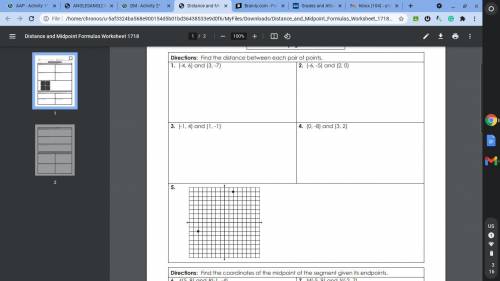Ever wondered how GPS systems pinpoint your location with remarkable accuracy? Or maybe you’ve gazed at a map, fascinated by the shortest route between two points. Behind these seemingly simple actions lies a profound principle: the ability to calculate distance and midpoint. These fundamental concepts, often found in geometry textbooks, are not mere abstract theories but powerful tools that shape our understanding of space and unlock countless applications in diverse fields.

Image: studyandanswers.com
This comprehensive exploration delves into the heart of the distance and midpoint formulas, unraveling their intricacies with clear explanations, insightful examples, and practical illustrations. We’ll uncover their historical roots, navigate through their mathematical essence, and discover their relevance in real-world scenarios, transforming these formulas from mere equations into keys to unlocking spatial knowledge.
The Distance Formula: Measuring the Gap Between Points
Imagine two points in a plane, each with its own unique coordinates. The distance formula acts as a ruler, meticulously calculating the straight-line distance between them. This formula is a direct application of the Pythagorean Theorem, a cornerstone of geometry that connects the sides of a right triangle.
Derivation and Application
To understand the formula’s derivation, consider the two points (x1, y1) and (x2, y2) in a plane. Connecting these points forms the hypotenuse of a right triangle. The legs of this triangle correspond to the differences in their x-coordinates (x2 – x1) and y-coordinates (y2 – y1). Applying the Pythagorean Theorem (a² + b² = c²), where ‘c’ represents the hypotenuse, we arrive at the distance formula:
Distance between (x1, y1) and (x2, y2) = √ [(x2 – x1)² + (y2 – y1)²]
Concrete Examples
Let’s bring this concept to life with a practical example. Suppose you want to find the distance between the points (2, 3) and (5, 7) on a map. Applying the distance formula, we get:
Distance = √ [(5 – 2)² + (7 – 3)²] = √ (3² + 4²) = √25 = 5 units
Thus, the distance between the two points is 5 units. This formula proves invaluable in various contexts, including:
- Navigation: GPS systems utilize the distance formula to calculate the shortest route between two locations.
- Mapping: Cartographers use it to determine distances between points on maps and create accurate representations of geographical features.
- Engineering: Civil engineers rely on the distance formula to calculate the length of bridges, roads, and other structures.

Image: amykub.blogspot.com
The Midpoint Formula: Finding the Center Point
The midpoint formula acts like a compass, guiding us to the exact midpoint between two given points. This formula provides the coordinates of the point that divides a line segment into two equal parts, effectively marking its exact center.
Derivation and Application
To visualize the midpoint formula, imagine a line segment connecting two points (x1, y1) and (x2, y2). The midpoint is the point that lies exactly halfway between these two endpoints. The formula derives from the average of the x-coordinates and the average of the y-coordinates:
Midpoint = [(x1 + x2)/2, (y1 + y2)/2]
Concrete Examples
Let’s consider an example to solidify our understanding. Suppose we need to find the midpoint of the line segment connecting the points (1, 4) and (7, 2). Using the midpoint formula, we calculate:
Midpoint = [(1 + 7)/2, (4 + 2)/2] = [4, 3]
Therefore, the midpoint of the line segment lies at the coordinates (4, 3). The midpoint formula has numerous applications, including:
- Geometry: Finding the center of a circle given two points on its circumference.
- Computer Graphics: Determining the midpoint of lines and curves in computer-aided design (CAD) software.
- Physics: Calculating the center of mass of objects, crucial for understanding their motion and stability.
Mastering Distance and Midpoint: Key to Geometric Insights
By understanding and applying the distance and midpoint formulas, we unlock a deeper appreciation for geometric concepts. These formulas empower us to measure distances, locate centers, and gain valuable insights into the properties of shapes and spatial relationships. From mapping to engineering to computer graphics, the applications of these formulas are as diverse as they are essential.
The Future of Distance and Midpoint: Embracing Advanced Concepts
The realm of distance and midpoint formulas extends beyond basic calculations. Advanced concepts, such as the distance between two lines or the midpoint of a curve, are actively explored in fields like advanced geometry, calculus, and computer science. As technology progresses, these fundamental formulas will continue to play a crucial role in shaping our understanding of the world.
Homework 3 Distance And Midpoint Formulas
Beyond the Textbook: A Call to Exploration
This journey through the distance and midpoint formulas is only the beginning. Explore further resources, experiment with different applications, and delve into their advanced variations. By engaging with these concepts, you’ll unlock a world of geometric insights and discover how these seemingly simple formulas shape our understanding of the world around us.






